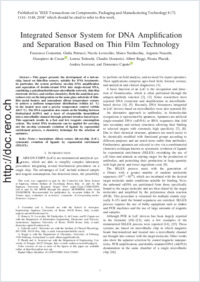Integrated sensor system for DNA amplification and separation based on thin film technology
- Costantini, Francesca School of Aerospace Engineering, Sapienza University of Rome, Italy
- Petrucci, Giulia Department of Information Engineering, Electronics and Telecommunications, Sapienza University of Rome, Italy
- Lovecchio, Nicola Department of Information Engineering, Electronics and Telecommunications, Sapienza University of Rome, Italy
- Nardecchia, Marco Department of Information Engineering, Electronics and Telecommunications, Sapienza University of Rome, Italy
- Nascetti, Augusto School of Aerospace Engineering, Sapienza University of Rome, Italy
- Cesare, Giampiero de Department of Information Engineering, Electronics and Telecommunications, Sapienza University of Rome, Italy
- Tedeschi, Lorena Institute of Clinical Physiology, Pisa, Italy
- Domenici, Claudio Institute of Clinical Physiology, Pisa, Italy
- Ruggi, Albert Department of Chemistry, University of Fribourg, Switzerland
- Placidi, Pisana Department of Engineering, University of Perugia, Perugia, Italy
- Scorzoni, Andrea Department of Engineering, University of Perugia, Perugia, Italy
- Caputo, Domenico Department of Information Engineering, Electronics and Telecommunications, Sapienza University of Rome, Italy
-
2018
Published in:
- IEEE Transactions on Components, Packaging and Manufacturing Technology. - 2018, vol. 8, no. 7, p. 1141–1148
French
This paper presents the development of a lab-on-chip, based on thin-film sensors, suitable for DNA treatments. In particular, the system performs on-chip DNA amplification and separation of double-strand DNA into single-strand DNA, combining a polydimethylsiloxane microfluidic network, thin-film electronic devices, and surface chemistry. Both the analytical procedures rely on the integration on the same glass substrate of thin-film metal heaters and amorphous silicon temperature sensors to achieve a uniform temperature distribution (within ±1 °C) in the heated area and a precise temperature control (within ±0.5 °C). The DNA separation also counts on the binding between biotinylated dsDNA and a layer of streptavidin immobilized into a microfluidic channel through polymer-brushes-based layer. This approach results in a fast and low reagents consumption system. The tested DNA treatments can be applied for carrying out the on-chip systematic evolution of ligands by exponential enrichment process, a chemistry technique for the selection of aptamers.
- Faculty
- Faculté des sciences et de médecine
- Department
- Département de Chimie
- Language
-
- English
- Classification
- Chemistry
- License
-
License undefined
- Identifiers
-
- RERO DOC 323345
- DOI 10.1109/TCPMT.2018.2792907
- Persistent URL
- https://folia.unifr.ch/unifr/documents/307262
Statistics
Document views: 108
File downloads:
- pdf: 244
